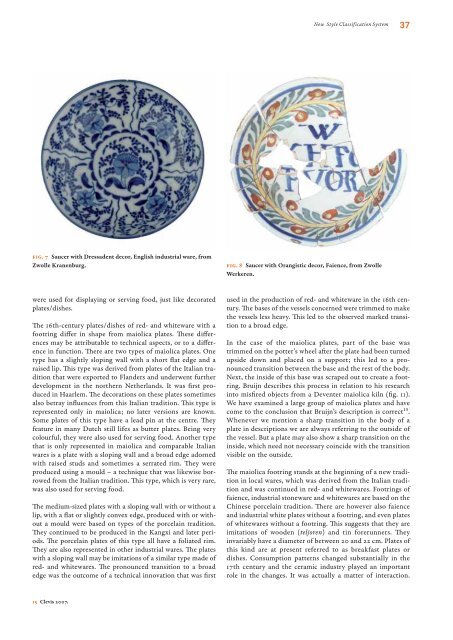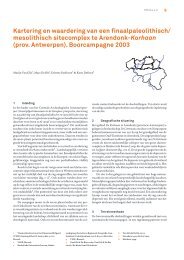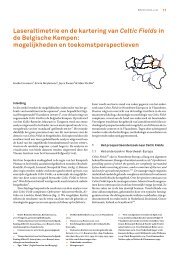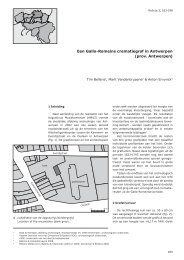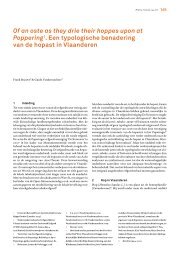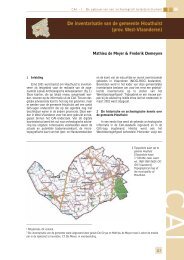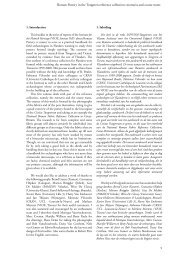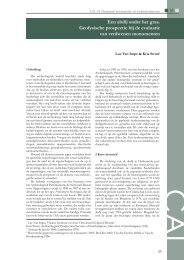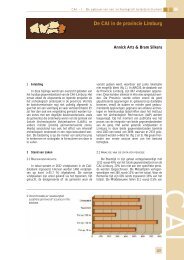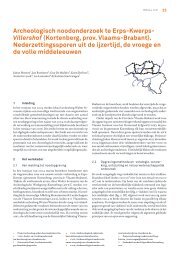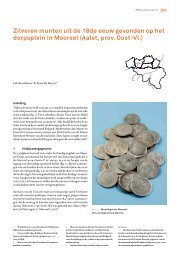Exchanging Medieval Material Culture Studies on archaeology and ...
Exchanging Medieval Material Culture Studies on archaeology and ...
Exchanging Medieval Material Culture Studies on archaeology and ...
Create successful ePaper yourself
Turn your PDF publications into a flip-book with our unique Google optimized e-Paper software.
were used for displaying or serving food, just like decorated<br />
plates/dishes.<br />
Th e 16th-century plates/dishes of red- <strong>and</strong> whiteware with a<br />
footring diff er in shape from maiolica plates. Th ese diff erences<br />
may be attributable to technical aspects, or to a diff erence<br />
in functi<strong>on</strong>. Th ere are two types of maiolica plates. One<br />
type has a slightly sloping wall with a short fl at edge <strong>and</strong> a<br />
raised lip. Th is type was derived from plates of the Italian traditi<strong>on</strong><br />
that were exported to Fl<strong>and</strong>ers <strong>and</strong> underwent further<br />
development in the northern Netherl<strong>and</strong>s. It was fi rst produced<br />
in Haarlem. Th e decorati<strong>on</strong>s <strong>on</strong> these plates sometimes<br />
also betray infl uences from this Italian traditi<strong>on</strong>. Th is type is<br />
represented <strong>on</strong>ly in maiolica; no later versi<strong>on</strong>s are known.<br />
Some plates of this type have a lead pin at the centre. Th ey<br />
feature in many Dutch still lifes as butter plates. Being very<br />
colourful, they were also used for serving food. Another type<br />
that is <strong>on</strong>ly represented in maiolica <strong>and</strong> comparable Italian<br />
wares is a plate with a sloping wall <strong>and</strong> a broad edge adorned<br />
with raised studs <strong>and</strong> sometimes a serrated rim. Th ey were<br />
produced using a mould – a technique that was likewise borrowed<br />
from the Italian traditi<strong>on</strong>. Th is type, which is very rare,<br />
was also used for serving food.<br />
Th e medium-sized plates with a sloping wall with or without a<br />
lip, with a fl at or slightly c<strong>on</strong>vex edge, produced with or without<br />
a mould were based <strong>on</strong> types of the porcelain traditi<strong>on</strong>.<br />
Th ey c<strong>on</strong>tinued to be produced in the Kangxi <strong>and</strong> later periods.<br />
Th e porcelain plates of this type all have a foliated rim.<br />
Th ey are also represented in other industrial wares. Th e plates<br />
with a sloping wall may be imitati<strong>on</strong>s of a similar type made of<br />
red- <strong>and</strong> whitewares. Th e pr<strong>on</strong>ounced transiti<strong>on</strong> to a broad<br />
edge was the outcome of a technical innovati<strong>on</strong> that was fi rst<br />
15 Clevis 2007.<br />
New Style Classificati<strong>on</strong> System 37<br />
Fig. 7 Saucer with Dressadent decor, English industrial ware, from<br />
Zwolle Kranenburg. Fig. 8 Saucer with Orangistic decor, Faience, from Zwolle<br />
Werkeren.<br />
used in the producti<strong>on</strong> of red- <strong>and</strong> whiteware in the 16th century.<br />
Th e bases of the vessels c<strong>on</strong>cerned were trimmed to make<br />
the vessels less heavy. Th is led to the observed marked transiti<strong>on</strong><br />
to a broad edge.<br />
In the case of the maiolica plates, part of the base was<br />
trimmed <strong>on</strong> the potter’s wheel aft er the plate had been turned<br />
upside down <strong>and</strong> placed <strong>on</strong> a support; this led to a pr<strong>on</strong>ounced<br />
transiti<strong>on</strong> between the base <strong>and</strong> the rest of the body.<br />
Next, the inside of this base was scraped out to create a footring.<br />
Bruijn describes this process in relati<strong>on</strong> to his research<br />
into misfi red objects from a Deventer maiolica kiln (fi g. 11).<br />
We have examined a large group of maiolica plates <strong>and</strong> have<br />
come to the c<strong>on</strong>clusi<strong>on</strong> that Bruijn’s descripti<strong>on</strong> is correct15.<br />
Whenever we menti<strong>on</strong> a sharp transiti<strong>on</strong> in the body of a<br />
plate in descripti<strong>on</strong>s we are always referring to the outside of<br />
the vessel. But a plate may also show a sharp transiti<strong>on</strong> <strong>on</strong> the<br />
inside, which need not necessary coincide with the transiti<strong>on</strong><br />
visible <strong>on</strong> the outside.<br />
Th e maiolica footring st<strong>and</strong>s at the beginning of a new traditi<strong>on</strong><br />
in local wares, which was derived from the Italian traditi<strong>on</strong><br />
<strong>and</strong> was c<strong>on</strong>tinued in red- <strong>and</strong> whitewares. Footrings of<br />
faience, industrial st<strong>on</strong>eware <strong>and</strong> whitewares are based <strong>on</strong> the<br />
Chinese porcelain traditi<strong>on</strong>. Th ere are however also faience<br />
<strong>and</strong> industrial white plates without a footring, <strong>and</strong> even plates<br />
of whitewares without a footring. Th is suggests that they are<br />
imitati<strong>on</strong>s of wooden (teljoren) <strong>and</strong> tin forerunners. Th ey<br />
invariably have a diameter of between 20 <strong>and</strong> 22 cm. Plates of<br />
this kind are at present referred to as breakfast plates or<br />
dishes. C<strong>on</strong>sumpti<strong>on</strong> patterns changed substantially in the<br />
17th century <strong>and</strong> the ceramic industry played an important<br />
role in the changes. It was actually a matter of interacti<strong>on</strong>.


